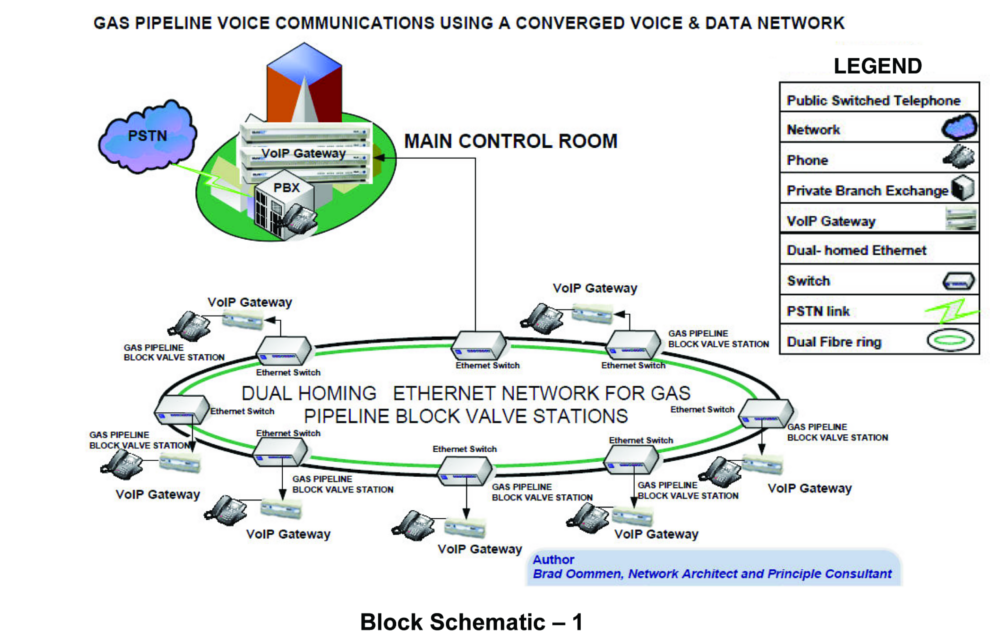May 2010 Vol. 237 No. 5
TechNotes
Communications Over A Converged Voice And Data Network For Gas Pipelines

Pipelines are an efficient means of transporting natural gas over long distances, from production locations to the market. However, managing a gas pipeline is an around-the-clock, complex operation that involves continuous monitoring. Hence we need a highly reliable, simple and dependable way to get voice, supervisory control and data acquisition (SCADA) telemetry traffic and, in some instances, video traffic from the gas pipeline block valve stations to the main control room.
Making use of the latest convergence technology and voice over IP (VoIP), companies operating gas pipelines can easily exchange voice and real-time SCADA telemetry data and video traffic, including real-time information about events linked to the operation of the pipeline between the pipeline’s Operation Control Center and the block valve stations.
The primary objective is to communicate effectively, and efficiently control the systems by making use of the latest convergence technology. This will enable pipeline operators and engineers to communicate back and forth while accessing information from anywhere along the pipeline block valve stations. Doing so will help the pipeline operator achieve much greater operational efficiency and better environmental performance.
For this discussion and implementation the system architecture (detailed in Block schematic – 1) would include the following typical components at each of the block valve stations:
- Fiber cabling that will dual home into an industrial Ethernet switch, essentially forming a logical redundant ring configuration (fiber-optic cable as a communication medium will provide electrical isolation, low error rate, ruggedness, flexibility, high bandwidth, lower latency, and immunity to crosstalk and interference.);
- Dual homing industrial grade Ethernet switch with built-in fiber ports (switches with rugged metal cases, support for dual power sources, extended temperature ranges, and two attachments into the network that provides two independent media paths); and
- VoIP gateways with support for multiple telephone interfaces and a minimum of two ports (voice media gateways that support capabilities such as adaptive echo cancellation, forward error correction, bad frame interpolation and dynamic jitter buffers so that voice quality is enhanced).
The network topology is a dual-homed logical ring; there are two independent media paths. If we experience a catastrophic failure, such as the fiber cable serving one of the media paths gets damaged or cut; the Ethernet network switch at the block valve station loses power, or the Ethernet network switch fails.
In all the instances mentioned, the traffic can then be rerouted on the other available media on the other available and already connected fiber cable, thus facilitating a quick fault recovery. This would minimize any potential downtime. The requirements for the selected components should dictate very high mean time between failure (MTBF) figures to offer the most reliable solution in a rugged, harsh and dusty environment along with overall system availability and reliability as key selection criteria.
For our application, a very useful and important feature available on VoIP gateways termed auto calling (the ability to setup auto calling between VoIP gateways) should be considered. A voice hotline from each of the pipeline block valve stations to the pipeline operations control room will aid in communicating effectively i.e. a private line automatic ring down (PLAR) setup between the various block valve stations and the pipeline operation control room.
One of the VoIP gateway vendors in the market that supports such a feature is Multi-Tech. For example, Multi-Tech’s MultiVoIP 8-port gateways can be deployed at the main control room providing voice inter connectivity with the company’s private branch exchange (PBX) and the public switched telephone network (PSTN). This series of gateways would interface with the PBX and also concurrently support hot line phones for instant voice communication between the control room and the various remote locations which are in this instance essentially the pipeline block valve stations.
The remote gas pipeline block valve stations would be equipped with the MultiVoIP MVP 210 2-port gateway. The phone hooked up to one of the gateway ports becomes an off-premise voice extension of the control room PBX. The gateways thus extend the reach of the main control room PBX into the remote block valve station locations simply and effectively.
The pipeline maintenance crew using this phone can place calls to any remote subscriber by simply dialing an extension number or calling external PSTN numbers. The other port on the gateway is setup with an auto call option (this enables the gateway at the block valve station to call the gateway at the control room automatically).
Now all the pipeline operator and or the maintenance crew has to do is pick up the phone and be automatically connected to the control room (without dialing any numbers which essentially serves functionally as a voice hot line). In the above scenario maintenance crews can continue to speak to the main control room even while the SCADA and the associated telemetry systems are concurrently being accessed.
A converged solution such as the one detailed here can maximize efficiency while achieving increased reliability, reducing maintenance and operation costs while keeping the system scalable and flexible.
Author
Brad (Biju) Oommen is a network architect and principal consultant. His work revolves around multi-vendor product and technology integration. It spans the domains of IP Telephony, Multi-media Contact Center, VoIP-H.323/SIP, SDH, EoS, WiFi/VoWiFi, SSL VPN, application acceleration, email and network security, SEM, SAN, IP networks, Fiber, and Microwave. He can be contacted at bijuoommenzurich@yahoo.com or bijuoommentoronto@yahoo.ca.





Comments